Nara Prefecture’s Japan Heritage Sites
Properties certified as Japan Heritage Sites by the Agency for Cultural Affairs, which began recognizing properties in 2015, are those examples of heritage deemed to tell the story of the nation’s culture and traditions. At present, there are seven such Japan Heritage narratives in Nara Prefecture. Here is an overview of Japan Heritage and an introduction to Japan Heritage in the prefecture.
What is Japan Heritage?
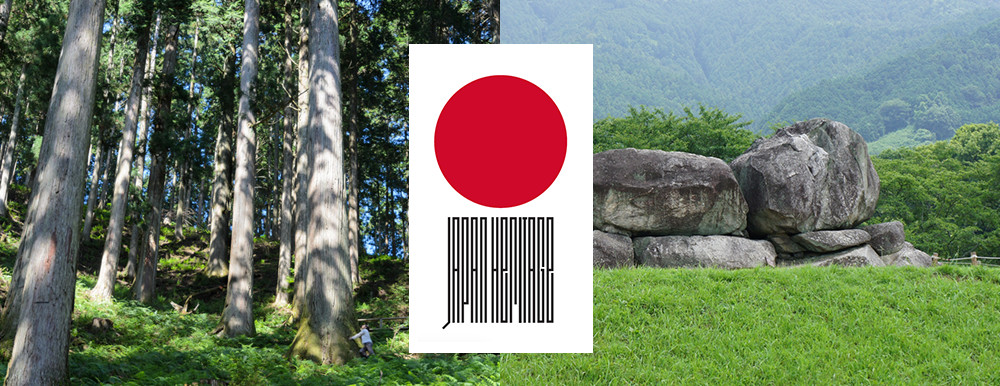
Japan Heritage refers to examples of heritage certified by the Agency for Cultural Affairs that provide a narrative to the culture and tradition of Japan through regional historic appeal or unique characteristics.
Its aim is to put the regions center stage—to maintain, utilize, and strategically promote cultural properties that together form these narratives for regional revitalization.
One difference between certification as Japan Heritage and inscription as World Heritage or designation as a Cultural Property is that while the emphasis on the latter is attaching value to a property or preserving it, the former is focused on revitalizing the regions.
Japan Heritage Designation requires:
1) Historically unique traditions or customs that have been passed on for generations.
2) A clear theme that supports the area’s appeal and that is represented at the core of the narrative. This can include cultural properties such as structures, archaeological sites, sightseeing spots, and local festivals.
3) Inclusion of a narrative, rather than simply a summary of regional history and a description of local cultural properties.
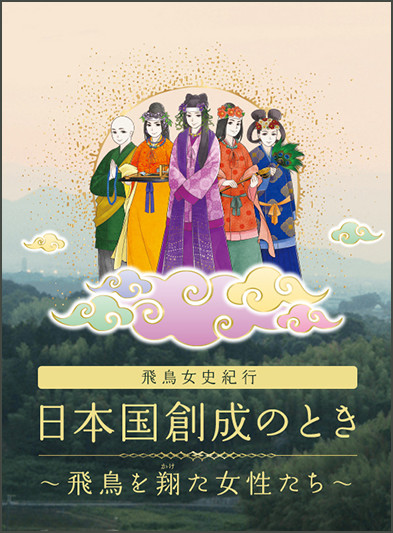
The Asuka Women who Fostered the Building of a New Nation
Certified in 2015
The Asuka period was one in which women played a strong, active role. In politics, this period saw Empress Suiko introduce Buddhism, Empress Saimei oversee the massive development of the capital at Asuka, and Empress Jito enact the Taiho Code, among other advances. In terms of culture, a large number of female poets, including Empress Jito and Princess Nukata, were composing poetry at this time, and in religion, the nun Zenshin-ni led the rise of Buddhism. In these ways, as Japan took its first steps as a nation, women were active in the spheres of politics, culture, and religion, and there is ample evidence of this remaining in Asuka.
Cultural properties
Fujiwara Palace Site, Ikazuchino-oka Toho Archaeological Site, Asuka Itabuki Palace Ruins, Asuka-dera Temple, Mausoleum of Emperor Tenmu and Empress Jito, Takamatsuzuka Tomb, etc.
Related municipalities
Asuka Village, Kashihara City, Takatori Town
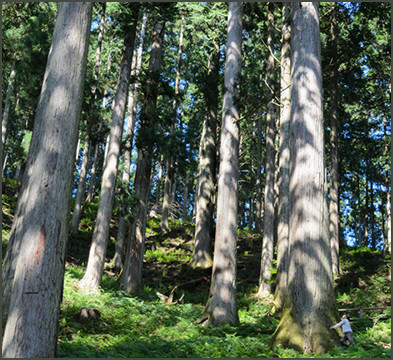
Yoshino, Birthplace of Japanese Afforestation
- The Mutual Relashionship between People and Forest -
Certified in 2016
For around 500 years, afforestation has been carried out in the Yoshino region, in the southern part of Nara Prefecture, and the result of the area’s unique afforestation techniques is beautiful Yoshino-zai lumber.
There is also untouched, natural woodland that has been protected in the areas surrounding paths used for ascetic practices that run along mountain ridgelines between shrines and temples. The way in which man-made forests and natural forests coexist is a characteristic of the region.
In the natural forests, one can see vestiges of the faith placed in the mountain deities in the temples, shrines and wayside shrines that dot the area.
A way of life that makes use of the forest’s resources is firmly rooted in the people that live in the region, something that has been passed down to the present.
Cultural properties tied to this narrative include Kimpusen-ji Temple’s Main Hall, Honzen-ji Temple, Shishinran (Lysionotus pauciflorus) Plant Communities, Yoshinomikumari-jinja Shrine, Ominesan-ji Temple, and Taru-maru Woodcraft Production Skills of Yoshino.
The related municipalities are Yoshino Town, Shimoichi Town, Kurotaki Village, Tenkawa Village, Shimokitayama Village, Kamikitayama Village, Kawakami Village, and Higashiyoshino Village.
Cultural properties
Kimpusen-ji Temple’s Main Hall, Honzen-ji Temple, Shishinran (Lysionotus pauciflorus) Plant Communities, Yoshinomikumari-jinja Shrine, Ominesan-ji Temple, Taru-maru Woodcraft Production Skills of Yoshino, etc.
Related municipalities
Yoshino Town, Shimoichi Town, Kurotaki Village, Tenkawa Village, Shimokitayama Village, Kamikitayama Village, Kawakami Village, Higashiyoshino Village
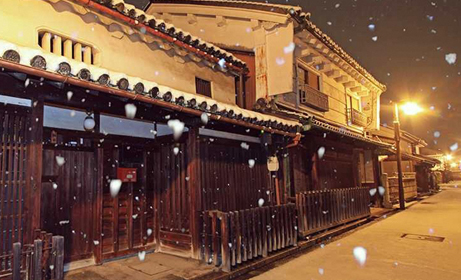
Takenouchi Kaido / Yokooji
- Japan's Oldest National Highway with a History of 1400 Years -
Certified in 2017
On the days of the spring and autumn equinoxes, the sun rises from Mt. Miwa, passes above Mt. Nijo, and sets in Osaka Bay.
For this reason, the straight road from Osaka in the west to Nara in the east is known as the ‘Road of the Sun.’ The ‘Road of the Sun,’ which is over 20 meters wide, was built by Emperor Suiko in the year 613.
In ancient times, missionaries from China arrived in Asuka City through Naniwa (present-day Osaka) along this road and introduced technology and Buddhist culture.
During the Middle Ages, the road connected many important trading towns, and in early modern times it flourished as an inn town for people traveling on pilgrimages to the Grand Shrine of Ise in Mie Prefecture. The Takenouchi Kaido/Yokooji historic road offers travelers, depending on the location, a fascinating variety of scenes and experiences.
Visitors to the heritage sites along this road will be able to encounter and appreciate the historical changes in the area over the past fourteen centuries.
Cultural properties
Takenouchi Kaido/Yokooji, Shimotsumichi, Nakatsumichi, Kamitsumichi, Naniwa Palace Site, Shitenno-ji Temple, Imai-cho Historic Town, Asuka-dera Temple
Related municipalities
Yoshino Town, Shimoichi Town, Kurotaki Village, Tenkawa Village, Shimokitayama Village, Kamikitayama Village, Kawakami Village, Higashiyoshino Village
Related links
Yoshino Town, Shimoichi Town, Kurotaki Village, Tenkawa Village, Shimokitayama Village, Kamikitayama Village, Kawakami Village, Higashiyoshino Village
Related pages on the Ikasu-Nara website
In-depth Investigation! Historical and Cultural Resources: Ancient Roads of Nara Prefecture
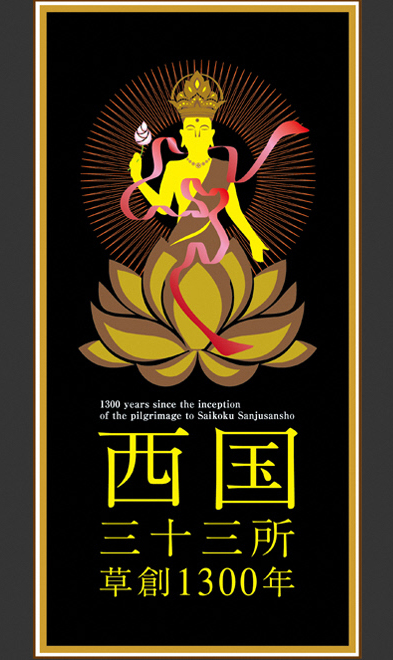
Kannon Pilgrimage of the 33 temples of Saikoku
- 1300 Years of Final Journeys
Certified in 2019
Preparing for one’s passing is not just a matter of sorting the affairs of one’s life before death.
To Japanese people, this preparation involves asking whether one has led a fulfilled spiritual life—one way of achieving this is by completing the 33-temple Saikoku Kannon Pilgrimage..
Japanese people are described as “cool” by foreigners, praised for their kindness, thoughtfulness, and industriousness—intrinsic parts of the Japanese spirit that in fact come from the teachings of Kannon, the Japanese name for the bodhisattva of compassion, with which they have become familiar..
Traveling between the Kannon temples on the route of the Saikoku Kannon Pilgrimage offers the chance to live with the kind of richness of spirit that is at the heart of the Japanese people.
Cultural properties
33 Temples of Saikoku, etc.
Related municipalities
Wakayama Prefecture: Nachikatsuura Town, Wakayama City, Kinokawa City
Osaka Prefecture: Izumi City, Fujiidera City, Ibaraki City, Minoh City
Nara Prefecture: Takatori Town, Asuka Village, Sakurai City, Nara City
Kyoto Prefecture: Uji City, Kyoto City, Kameoka City, Miyazu City, Maizuru City
Shiga Prefecture: Otsu City, Nagahama City, Omihachiman City
Hyogo Prefecture: Takarazuka City, Kato City, Kasai City, Himeji City
Gifu Prefecture: Ibigawa Town
Related links
1300 Years Since the Inception of the Pilgrimage to Saikoku Sanjusansho
Traveling the Pilgrimage of the 33 Temples of Saikoku
Related pages on the Ikasu-Nara website
Traveling the Pilgrimage of the 33 Temples of Saikoku
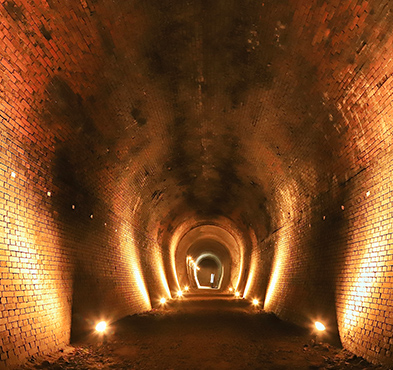
Overcoming Problems in Kame-no-se, the Heart of the Tatsuta Kodo Ancient Road
—Please No More Landslides!—
Certified in 2020
The area of Kame-no-se is located on the border between Nara and Osaka prefectures, and is a land of valleys where the waters of the Nara plateau collect. It is a dangerous area, in which landslides have been a common occurrence for around 40,000 years, but which since ancient times, as the western entrance to the capital, has been at the center of transport, finance, and flood control. People from the Asuka period to the Nara period composed songs about the road, which developed through the coming and going of the products of civilization. When people thought of the Tatsuta Kodo, though, the fear of landslides was not far behind. Since prehistory to the present day, people have prayed to the wind deities of the region for safe travel and national stability, and the latest techniques and technologies have always been used to protect this special land.
Try walking the road now, with the feel of the wind on your skin. See the railway tunnel buried under gravel and touch the civil engineering works built using techniques that will support the lives of future generations. When you finally cross over Kame-no-se, you’ll gain an understanding of the Japanese people who coexist with this wonderful nature.
Cultural properties
Tatsuta-taisha Shrine, Old Osaka Railway Kamenose Tunnel, Kameiwa Cave, Matsuokayama Tomb, Remains of Heiryu-ji Temple, Remains of Chishiki-ji Temple, Remains of Kawachikokubun-ji Temple, Remains of Takeharai-tongu Imperial Villa, Goza-mine Peak (Mt. Tatsuta, Land of Legends), Mt. Shiba, Reitaisai and Fuchintaisai festivals, Tatsuta-kagura Dance, etc.
Related pages on the Ikasu-Nara website
No Landslide Anymore! Crossing ‘Kamenose’, the heart of the ancient Tatsuta Kodo
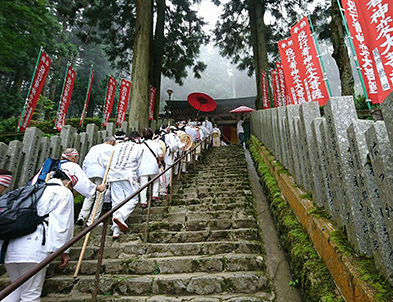
Mt. Kongo Renge-taisai Grand Festival
Katsuragi Shugen—The Birthplace of Shugendo, a Tradition Preserved and Passed Down by Mountain Folk
Certified in 2020
The Izumi Mountain Range runs east to west across the borders between Wakayama and Osaka prefectures. From this, the Mt. Kongo lands extends from south to north on the border of Osaka Prefecture and Nara Prefecture. Of this, a 112 kilometer stretch of ridge is known as Katsuragi, and is revered for the large number of deities said to live there.
En-no-gyoja, believed to be the founder of the Shugendo sect of mountain asceticism, first practiced here, so the area is known as the land of Katsuragi Shugen. Nara Prefecture’s Mt. Omine is an important place for those who practice Shugendo, and forms part of a UNESCO World Heritage Site, Sacred Sites and Pilgrimage Routes in the Kii Mountain Range..
The area is also home to 28 kyozuka, small holes in the ground in which En-no-gyoja buried each of the chapters of the Lotus Sutra as an offering. The practice of traveling between the holes from number one to number twenty-eight, and visiting the waterfalls, large stones, temples, shrines, and wayside shrines in the area and following Shugendo, is known as “Katsuragi Shugen.” Even today, practitioners walk between the kyozuka, connected temples and shrines, stone Buddha carvings, and other important spots.
Cultural properties
Mt. Kongo, Taima-dera Temple, Temporin-ji Temple, Katsuragihitokotonushi-jinja Shrine, Takao-ji Temple, Tomogashima Johon-kutsu Cave, Kishukataura Saitodaigomaku Ceremony, Nakatsugawagyoja-do Temple, Katsuragi-odori Dance, etc.
Related municipalities
Wakayama Prefecture: Wakayama City, Hashimoto City, Kinokawa City, Iwade City, Katsuragi Town
Osaka Prefecture: Kishiwada City, Izumisano City, Kawachinagano City, Izumi City, Kashiwara City, Hannan City, Misaki Town, Kanan Town, Chihayaakasaka Village
Nara Prefecture: Gojo City, Gose City, Kashiba City, Katsuragi City, Oji Town
Related pages on the Ikasu-Nara website
A Japan Heritage: The Katsuragi Shugen
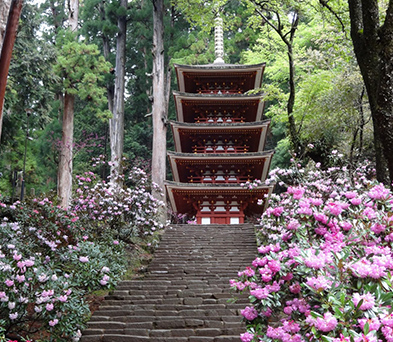
Timeless Protection of a Soothing, Sacred Land
—Nyonin Koya and Women, Then and Now—
Certified in 2020
Until modern times, it was forbidden for women to enter the sacred land of Mt. Koya, and women could not visit temple or shrine grounds. During that time, there was a specific temple that would listen to women’s prayers for the souls of their departed relatives or for future peace, Muro-ji Temple—also known as Nyonin Koya (“Women’s Koya”).
The elegantly curved roof of the temple building, the gentle face of the Buddha sculpture that silently listens to visitors’ prayers, the surrounding trees that show the changing of the seasons—this tranquil space is expressed magnificently in the pictures and descriptions of the meishozue, Edo-period guidebooks. The women’s temple so described has stood the test of time, adapting as times, and women, have changed. To this day, Nyonin Koya continues to offer visiting women comfort.
Cultural properties
Uda City: Muro-ji Temple, Butsuryu-ji Temple, Ono-ji Temple, Anzan-ji Temple
Osaka and Wakayama prefectures: Kongo-ji Temple, Amano Kaido, Koya Kaido, Jison-in Temple, Makiomichi, Choishimichi, Fudozakaguchi Nyonin-do Temple, etc.
Related municipalities
Wakayama Prefecture: Kudoyama Town, Koya Town
Osaka Prefecture: Kawachinagano City
Nara Prefecture: Uda City
